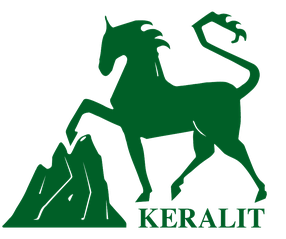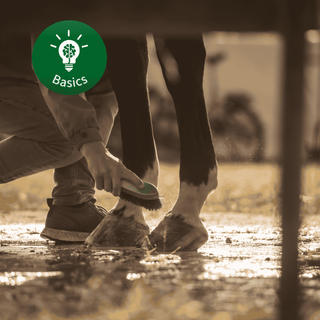No hoof, no horse. This old saying sums up the importance of healthy hooves. The weight of the horse creates considerable strain on the limbs when in motion. Healthy and well-maintained hooves are therefore crucial to ensuring that the horse can move without pain or consequential damage to higher structures such as tendons, ligaments or bones.
In this blog post you will find all the important points of the Hoof care summarized. From the importance of hoof care to the functions of the hoof, shoeing and treatment, the foundation of hoof health, the right Hoof care and the necessary tools as well as frequently asked questions.
Why is hoof care so important for horses?
Importance of hoof care for the health of the horse
A horse's hooves can be compared to human feet. Without them, a normal, healthy gait is not possible. In nature, horses move for at least 16 hours a day and are therefore dependent on a correct, healthy gait. With this high need for movement, misalignment of the hooves quickly leads to wear and tear and overstressing of joints and tendons.
Effects of inadequate hoof care on health
If hoof care is neglected, this can lead to various diseases. The neglect of everyday hoof care by the horse owner often leads to diseases such as e.g. the the development of thrush and hoof abscesses or cracked, dry hooves. Long-term consequences such as malpositions or laminitis (in this case stress laminitis) are often caused by unsuitable posture, overloading or irregular hoof trimming.
Horse hoof structure: What functions does a horse's hoof have?
The hoof as a tactile organ: perception and movement safety
A functional horse hoof consists of different structures that together enable it to perform a variety of tasks. One of these tasks is to contribute to the horse's sense of touch. The horse can feel the ground conditions with the hoof thanks to the corium. The information about the condition of the ground is incorporated into horn production. The harder the ground, the more resistant the horn is produced. In addition, the horse can quickly adapt its movements to the unevenness it senses in order to remain balanced at all times.
The hoof pump: circulatory support through the hoof
In addition to its contribution to the sense of touch, the hoof is also for the cardiovascular system of the horse. During movement, the horn capsule of the hoof expands and contracts with every step. This ensures that the blood reaches all the vessels in the hoof and supports the return flow of blood to the heart. This process is called the hoof mechanism.
The hoof as a shock absorber: protection against stress damage
The healthy hoof mechanism ensures that the hoof expands when loaded and contracts again when unloaded. These elastic deformations reduce the stress peaks that occur on the hoof. Impacts on the associated ligaments, tendons and joints are also reduced. The elastic deformation of the hoof amounts to several millimetres during loading and unloading.
Need for horseshoes - barefoot or horseshoes?
Why do horses need horseshoes?
The growth of a horse's hoof is naturally subject to certain limits. If hoof wear is greater than growth, the horse needs suitable hoof protection. If excessive wear is only caused by human activity, e.g. riding or exercise, suitable hoof boots can help.
If the hooves are permanently exposed to excessive wear, for example in an open stable with a stony floor, the horse needs permanent hoof protection, such as horseshoes or adhesive shoes. In addition, the use of the horse may also require horseshoes, such as for sliding stops in Western horses or the need for studs for better grip in show jumping and eventing horses. Furthermore, the treatment of hoof diseases or congenital conditions of the hooves and overlying structures on the horse's leg may also require horseshoes or special orthopedic shoes.
Advantages and disadvantages of bare hoof vs. horseshoe
| Advantages bare hoof | Disadvantages bare hoof |
| Natural hoof mechanism | Growth may not be able to compensate for wear - excessive abrasion |
| natural wear and tear | Risk of abscess due to trapped stones |
| No accumulation of snow in winter | Misalignments can become more pronounced |
| No penetration of bacteria into the nail holes | no studs possible |
| Reduced risk of injury | The horse can be sensitive on stony and uneven ground |
| Reduced risk of slipping | Not possible for every horse (e.g. extremely flat hooves with a low sole arch) |
| Lower costs | Hooves can break out more frequently |
Important pillars of hoof health
Influence of nutrition on the development of healthy horse hooves
A balanced diet with the right horse feed is essential for the development and quality of healthy horse hooves. Nutrient deficiencies have a negative effect on horn production and often only become apparent at a late stage, for example in the form of growth grooves at the coronet band. Proteins, B vitamins, biotin, and the essential amino acids lysine and methionine are particularly important for optimal horn formation, as horses cannot produce these themselves. A balanced supply of vitamins, minerals, and trace elements also supports the health of the entire horse organism.
Regular care as the basis for healthy hooves in horses
Proper care of the horse's hooves is essential for its health and well-being. Whether shod or barefoot, it is important to check the hooves daily for cracks, chipping, embedded stones or loose shoes. A thorough, dry cleaning with a brush and hoof pick removes dirt and embedded stones. These can quickly lead to hoof abscesses in the white line.
The frog clefts should also be cleaned thoroughly and dry. If the frog clefts deepen and become damp or soft, they should be treated immediately with an care product against thrush treated immediately. In addition, the hooves should be regularly treated with a suitable care product such as hoof oil and/or a hoof hardener to keep them healthy. hoof hardener should be applied regularly. This makes them elastic and resilient.
What should be considered during hoof care?
External influences such as weather and ground
Especially in winter, the hooves of horses in our latitudes often come into contact with a lot of water (wet pastures, paddocks, frequent washing) over long periods of time. In the long term, this constant moisture leads to rotting of the horn. The horn of the frog and the horn of the white line are mainly affected.
In summer , hooves are exposed to extreme weather conditions. The constant change between hot, dry and cooler, wet periods puts a lot of strain on the hoof horn. Drying and water absorption cause the horn to swell and shrink, changing not only its volume but also its elasticity. Large fluctuations in volume within and between the layers of horn create tension, which can cause cracks. Especially when kept on sandy, dry ground , the hooves dry out quickly, as the sand further dehydrates the horn.
How often should hooves be trimmed?
A horse's hooves should be cleaned daily and checked for problems such as embedded stones, rotting processes or breakouts. In addition, the hooves should be treated 2-3 times a week with suitable care products.
What accelerates hoof growth in horses?
The basic prerequisite for good hoof growth is always an optimal supply of nutrients and energy through feed. In addition, exercise is important, as it promotes blood circulation and thus growth. Furthermore, the Keralit Laurel Ointment can also be used to support this by massaging it into the coronet band. The high content of laurel oil promotes blood circulation and thus growth.
Instructions for cleaning horse hooves
Step-by-step instructions: How do you clean a hoof with a hoof pick?
To clean the hooves, stand at the side of the horse. Your back should point towards the horse's head and your shoulder towards the horse. Pick up the hoof with the hand that is closer to the horse and use the hoof pick with the other hand.
First, use the tip of the hoof pick to remove the coarse dirt and stones from the sulci and the sole. The frog sulci and sole are then brushed until the dirt has been completely removed. On an unshod horse, the white line is then checked for stones that have penetrated the foot and were not previously visible due to the dirt.
Hoof care: Tips for daily cleaning
The daily cleaning and removal of stones with the aids described above is the be-all and end-all. If the frog clefts deepen and become damp or soft, they should be treated immediately with a care product against thrush . In addition, regular rounding off the hoof wall with the help of a hoof rasp can prevent chipping of unshod hooves.
Basic equipment for hoof care: tools and aids
What belongs in the basic hoof care kit?
To be properly equipped for hoof care, you should have a hoof pick, a coarse brush or soft wire brush, a stone remover or hoof nail, a hoof rasp and a hoof knife.
Hoof knife, hoof pick and other important tools
hoof picks, brushes and tools for removing stones are used as described above for trimming the hooves. Hoof knives and rasps can be used to cleanly remove broken and protruding pieces of horn that are no longer functional and to smooth edges.
Hoof oil or hoof grease: Which is better for care?
Conventional oils and greases seal the hoof for several days, preventing it from absorbing or releasing moisture. For effective care, you should therefore use a water-friendly product such as Keralit Hoof Elast or Keralit intment . Water-friendly products allow moisture to be exchanged freely in the hoof.
FAQ: Frequently asked questions about horse hooves and hoof care
What do good hooves look like?
A healthy horse hoof has a smooth, straight, and evenly stretched hoof wall without cracks or breaks. The white line and frog are free from diseases such as white line disease or thrush. Hoof growth and wear are in balance. Any deviations require professional correction by a farrier or hoof trimmer.
Do the horses like the hoof care?
For comfortable hoof care, the horse should give its hooves without any problems and stand in a stress-free environment. The treatment of hoof problems, such as thrush can be unpleasant for the horse. It is important to respond to the horse's needs and carry out the treatment as carefully as possible, while still ensuring that it is as effective as possible.
When should the farrier come?
Regular hoof trimming by the farrier or hoof trimmer is essential for healthy hooves for horses. Hoof tr imming should therefore take place every 6-8 weeks. Signs that hoof trimming is necessary include chipping and cracking, outward bending of the hoof walls, uneven hoof walls, the formation of a flare on the horse's toe, increased stumbling and loose or lost shoes.


